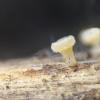
25-11-2016 13:54
 Stephen Martin Mifsud
Stephen Martin Mifsud
Hi, I found numerous seeds of Washingtonia robusta

28-10-2025 22:22
 Bernard Declercq
Bernard Declercq
Hello.I'm searching for the following paper:Punith

28-10-2025 19:33
 Nicolas Suberbielle
Nicolas Suberbielle
Bonjour à tous,Je voudrais votre avis sur cette r

28-10-2025 15:37
Carl FarmerI'd be grateful for any suggestions for this strik

28-10-2025 11:29
 Tanja Böhning
Tanja Böhning
Hello, I found this very small (ca 0,5mm) yellow

27-10-2025 00:34
 Francois Guay
Francois Guay
I found this strange species in Québec,Canada, gr

27-10-2025 15:29
 Michel Hairaud
Michel Hairaud
Bonjour à tous, Avec Elisabeth Stöckli nous avo

26-10-2025 13:39
Joaquin MartinHi,I found this fungus in a mixed forest of spruce
Calycina?
David Chapados,
21-06-2025 22:27
 Hi,
Hi,Is this a Calycina? C. herbarum?
Growing on an herbaceous stem (could possibly be mint), Quebec, Canada.
Spores 12,6-17,5 x 2,2-3,0um.
Asci amyloid, 50,4 x 6,4um.
Ingo Wagner,
21-06-2025 22:59

Re : Calycina?
Hi David!
The contents of the paraphyses are similar to those of Cyathicula.
What do the excipulum cells look like?
Greetings
Ingo
The contents of the paraphyses are similar to those of Cyathicula.
What do the excipulum cells look like?
Greetings
Ingo
David Chapados,
21-06-2025 23:51

Re : Calycina?
This looks like a great suggestion. I must admit I overlooked the excipulum... I'll have another look and update when it's done.
Thank you very much!
Thank you very much!
David Chapados,
22-06-2025 02:48

Re : Calycina?
The excipulum cells are made of parallel hyphae (picture added on iNat).
Is there an accessible key for this genus? I saw that there's one in the work of Carpenter, but can't find it online.
Is there an accessible key for this genus? I saw that there's one in the work of Carpenter, but can't find it online.
Hans-Otto Baral,
22-06-2025 09:13

Re : Calycina?
I also suggest Cyathicula. Carpenter's revision of Crocicreas includes numerous species that are today unrelated to Cyathicula or even Helotiales, such as Allophylaria.
Cyathicula is extremely badly worked out. In my folder are numerous unnamed collections and nom. provs. But I would anyway classify yours as C. cyathoidea in a wider sense, despite the long spores.
The presence of crystals on the outside is typical of many species, but inconsistent.
David Chapados,
22-06-2025 13:55

Re : Calycina?
Thank you!

